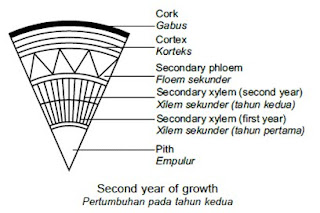Aim : To study the adaptations for support in water hyacinth
Observations


Discussion
1. The plant floats on the surface of the water with the roots immersed in water.
2. Many air sacs are found between the cells. These air sacs provide buoyancy enabling the plant to float.
3. The air sacs in the leaves and roots provide buoyancy enabling the plant to float in water. The air sacs allow gaseous exchange in the roots. The leaves are able to photosynthesise
Conclusion :The water hyacinth plant has aerenchyma tissues filled with a lot of air sacs to enable it to float on the surface of the water.
Pg 24
Aim : To identify support in woody plants


Discussion :
1. Xylem
2. Secondary xylem
3. One layer of wood tissues represent one year of growth.
4. Collenchyma and sclerenchyma
Conclusion :
Support in woody plants is provided by secondary xylem tissues.
Pg 26-30
1. B 2. A 3. A 4. C 5. C 6. A 7. B 8. A 9. D 10. C
11. A 12. D 13. D 14. A 15. C 16. A
Subjective Questions
Section A
1. (a) (i) P : Tendon Q : Ligament
(ii) Tough and non-elastic
(b) (i) Joins two bones
(ii) Tough and elastic
(c) Muscles work in pairs and oppose each other.
One set of muscles contracts whereas the other set relaxes to bring about movement. These contracting and relaxing actions are known as antagonistic action.
(d) Biceps and triceps
2. (a) Biceps
(c) When P contracts, Q relaxes. The radius is pulled upwards to bend the arm.
(d) Suffers from osteoarthritis. Cartilage degenerates and causes friction etween the bones during movement. Joint is painful and hampers movement at the knee.
(e) Warm up exercise increases rate of heart pumping blood. More oxygen is transported by the blood to the tissues. Warm up exercises loosen up muscles
and joints. Elasticity of muscle increases and thus increases the contraction and force of muscle fibres.
3. (a) (i) Woody terrestrial plant
(ii) Xylem
(iii) Xylem vessels have lignified walls which provide mechanical support to the plant. Secondary growth produces more xylem tissues which become wood. This provides more support as the plant grows older.
(b) (i) Water such as pond or lake
(ii) Many air sacs
(c) Plant P is an aquatic plant which floats in water. The presence of numerous air sacs enables the plant to float.
(d) Aquatic plants are partly supported by the buoyancy of the water they grow in. They rely mainly on aerenchyma tissues with abundant air sacs for support. Aerenchyma tissues are absent in terrestrial plants.



No comments:
Post a Comment